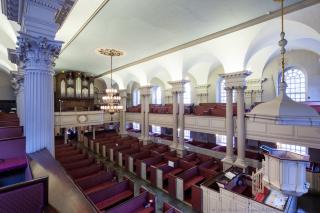Advertisement
By 1830, all but one of Boston’s Congregational churches and twenty of the twenty-five oldest congregations in Massachusetts had become Unitarian. Times have changed—but Unitarian Universalists visiting Boston still express amazement that three historic churches within a short walk of each other are home to UU congregations today. (There are five more within five miles.)
King’s Chapel was built as a Church of England at the edge of the city’s oldest burial ground in 1754, the first stone building in Boston and one of the first buildings in the colonies designed by an architect, Peter Harrison. Inside you can see the royal governor’s pew as well as emblems of the crown and bishop’s miter (on the organ) that go back to the church’s colonial, pre-Unitarian days. The church modified the Book of Common Prayer to remove Trinitarian references in 1785, and ordained a Unitarian minister, making it the first openly Unitarian church in America. (It uses a Unitarian Anglican liturgy to this day.) Busts of its first four Unitarian ministers stand in the chancel. The tall wineglass pulpit, under a suspended sounding board, dates back to 1717. The congregation was the first in America to install an organ, in 1713.
First Church dates back to the city’s founding by Puritans in 1630. Its current home, in the nineteenth-century Back Bay neighborhood, is a contemporary concrete edifice built amid the ruins of a Victorian Gothic church destroyed by fire in 1968. The modern interior shimmers with paper-thin copper strips set into creases in the wall, with the names of its ministers and members written on them. Many other congregations folded into First Church over the years, including Second Church, which a young Ralph Waldo Emerson served as minister; his bust stands in the lobby.
Arlington Street Church, a grand neoclassical church completed in 1861, faces the Public Garden and an imposing statue of the Unitarian minister William Ellery Channing (1780–1842), who served the church in its previous location on Federal Street. Visitors marvel at the church’s collection of Tiffany stained glass windows, the largest collection in a single church, installed between 1898 and 1933. The congregation hosted the state convention that ratified the U.S. Constitution in 1787; almost 200 years later, its ministers burned draft cards during the Vietnam War. Its carillon of bells, played by hand, ring out on Sundays and holidays, from Christmas Eve to Pride.
